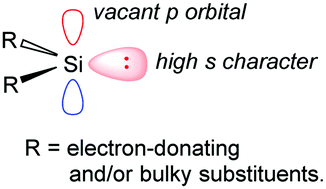Where silylene–silicon centres matter in the activation of small molecules
Abstract
Small molecules such as H2, N2, CO, NH3, O2 are ubiquitous stable species and their activation and role in the formation of value-added products are of fundamental importance in nature and industry. The last few decades have witnessed significant advances in the chemistry of heavy low-coordinate main-group elements, with a plethora of newly synthesised functional compounds, behaving like transition-metal complexes with respect to facile activation of such small molecules. Among them, silylenes have received particular attention in this vivid area of research showing even metal-free bond activation and catalysis. Recent striking discoveries in the chemistry of silylenes take advantage of narrow HOMO–LUMO energy gap and Lewis acid–base bifunctionality of divalent Si centres. The review is devoted to recent advances of using isolable silylenes and corresponding silylene–metal complexes for the activation of fundamental but inert molecules such as H2, COx, N2O, O2, H2O, NH3, C2H4 and E4 (E = P, As).

- This article is part of the themed collection: Small molecule activation, from biocatalysis to artificial catalysis


 Please wait while we load your content...
Please wait while we load your content...